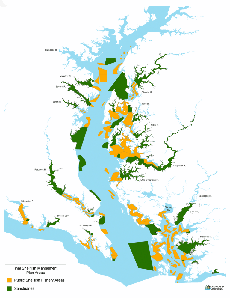Ecological Restoration - Sanctuaries & ReservesThe
2019 Chesapeake Bay Oyster Management Plan adopted pursuant to Natural Resources Article, §4-215, Annotated Code of Maryland and Code of Maryland Regulations (COMAR) 08.02.01A directs the department to establish oyster sanctuaries under Strategy 4.2. The authority of the department to establish and regulate opening and closing of Harvest Reserves as a fisheries management tool exists under Natural Resources Article §4-1009.1 of the Maryland Annotated Code and COMAR 08.02.04.14.
Current Maryland Oyster Sanctuaries
 Following recommendations put forth in the Oyster Advisory Commission's 2008 Legislative Report and a comprehensive Federal/State Programmatic Environmental Impact Statement for Oyster Restoration in Chesapeake Bay completed in June 2009, The governor announced Maryland's Oyster Restoration and Aquaculture Development Plan in December of 2009. One objective of this plan was to expand the oyster sanctuary network from 9% to 25% (~9,000 acres) of remaining oyster bar habitat over a broad geographical distribution. Within this enlarged sanctuary network, a number of large areas were selected (up to entire river systems) in strategically located areas for targeted restoration.
Following recommendations put forth in the Oyster Advisory Commission's 2008 Legislative Report and a comprehensive Federal/State Programmatic Environmental Impact Statement for Oyster Restoration in Chesapeake Bay completed in June 2009, The governor announced Maryland's Oyster Restoration and Aquaculture Development Plan in December of 2009. One objective of this plan was to expand the oyster sanctuary network from 9% to 25% (~9,000 acres) of remaining oyster bar habitat over a broad geographical distribution. Within this enlarged sanctuary network, a number of large areas were selected (up to entire river systems) in strategically located areas for targeted restoration.
Prior to 2009, Maryland's oyster sanctuaries covered only 1,475 acres of bottom habitat. Individually, the sanctuaries were sparsely distributed and small making them difficult to enforce against illegal poaching and relatively ineffective as restoration tools. In 2009, the department added three new oyster sanctuaries that more than doubled the percentage of protected area yet still protected only 2,581 acres (9%) of geographically dispersed oyster habitat. The remainder of Maryland's portion of the Bay, exclusive of private lease areas, was left open to public shellfish harvesting.
The newest sanctuary areas established in September 2010 were specifically targeted to:
- Facilitate development of natural disease resistance – the long-term strategy for restoring oysters;
- Protect about half of the Bay's most productive oyster grounds ("best bars") as determined by an analysis of Fall Survey data compiled from 1996 to 2007 (see more detail in FAQ section);
- Have high restoration potential based on water quality and other factors;
- Provide essential natural ecological functions that can not be obtained on a harvest bar;
- Serve as reservoirs of reproductive capacity, generating larvae to populate other areas, including public shellfish fishery areas;
- Provide a broad geographic distribution across all salinity zones;
- Increase our ability to protect these important areas from poaching.
It is anticipated that both recreational and commercial fishing will benefit from improved oyster bar habitat in sanctuaries because oyster bar habitat provides critical habitat to blue crabs, striped bass, white perch and other important finfish species. Oysters within sanctuaries are also expected to increase the abundance of adult oysters whose larvae are expected to settle not only within the sanctuary, but also on public shellfish fishery areas in the vicinity of the sanctuaries. Here is a complete list of
Maryland's current oyster sanctuaries, listed by region and inclusive of coordinates, and as shown on the map above.
Clamming and Leasing in SanctuariesAs a result of the dramatically expanded sanctuary network, sanctuaries no longer solely consist of natural oyster bars. Instead, the expanded sanctuary network includes additional non-oyster bottom that surrounds the larger areas of interconnected natural oyster bars. The 2010 legislation also modified Strategy 4.2 of the Oyster Management Plan to allow clamming from within the new sanctuary boundaries. The plan limits clamming to existing clamming areas, and maintains the existing 150 foot buffer from any natural oyster bar and leased area. The prohibition of all wild shellfish harvest, including clamming, is maintained for previously established sanctuaries.
As shellfish aquaculture operations provide many of the same benefits that natural oyster bars provide, current law allows the Department to issue aquaculture leases in oyster sanctuaries. No more than 10% of a sanctuary may be leased for aquaculture, and leases must be at least 150 feet from a Yates Bar. Details may be found in
COMAR Statute §4–11A–06 and Statute §4–11A–08.
Sanctuaries vs. ReservesSanctuaries are areas where the wild harvest of oysters, and both oysters and clams in previously established sanctuaries, is prohibited (see above). They often contain oyster restoration projects to help enhance native oyster populations for their environmental benefits. Reserves are areas periodically seeded with oysters or otherwise restored by the Department, then later opened for commercial harvest when the shellfish meet certain criteria, such as a minimum size limit of not less than 3 inches, low disease prevalence and intensity, and other biological reference points. Harvesters are responsible for culling oysters on the Reserve from which they are caught and returning every shell to the bar to serve as settlement substrate for oyster larvae. The department opens and closes Reserve bars through an established public notice process. Currently, Maryland has designated 12 reserve areas; however, there are a limited number of resources (shell and funding) to support the continued maintenance of reserves.
Note: Other portions of Maryland's oyster harvesting waters may be periodically closed to harvest due to contamination, or high potential for contamination, by fecal coliform bacteria in accordance with the Maryland Department of the Environment (MDE) classification status of oyster and clam harvesting waters. The MDE Shellfish Harvesting and Closure Area Maps are available on their website.
Frequently Asked Questions (FAQs) About Sanctuaries